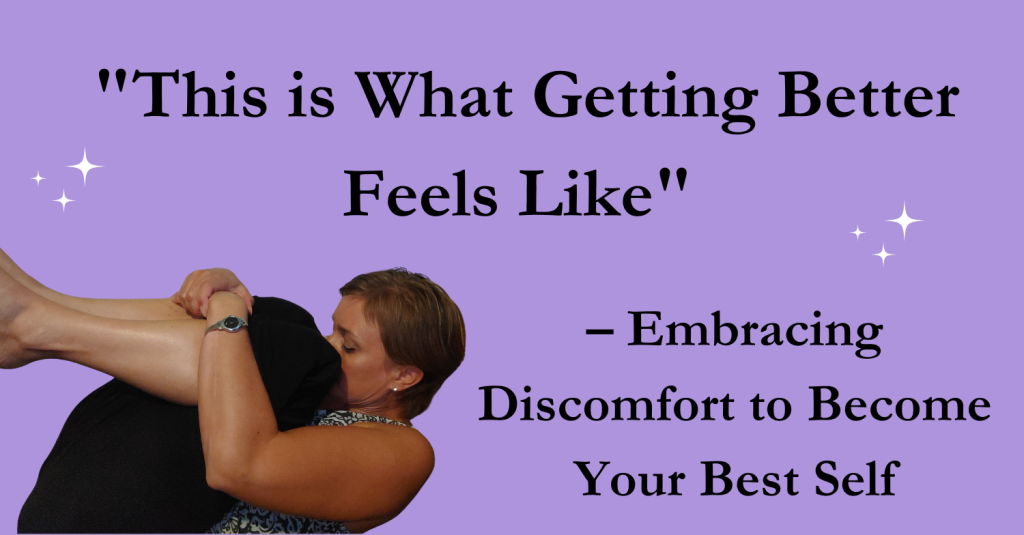– A Mantra for Becoming Your Best Self
We’ve all been there — that moment when our muscles burn, our minds scream, and every fiber of our being wants to give up. Or when we face resistance to doing the very thing we know would make us better if we just did it. Or when we’re struggling to resist the temptation of something we know we’ll regret later.
In these moments, it’s easy to reach for an escape, a distraction, or an excuse. As Nir Eyal, author of Indistractable, explains, this urge isn’t just about a lack of willpower—it’s rooted in a fundamental human drive to avoid discomfort. But what if we saw these moments differently? What if, instead of turning away from discomfort, we embraced it as a sign that we’re on the right path?
This is where Nir Eyal’s mantra, “This is what getting better feels like,” has profoundly changed my life. It has become my guiding light through every challenge, reminding me that discomfort is not a barrier but a bridge to becoming my best self.
The Underlying Drive: Avoiding Discomfort
Nir Eyal’s work reveals a fundamental truth: most of our behaviours—whether it’s reaching for our phones, avoiding that difficult task, or indulging in distractions—stem from a desire to avoid discomfort. This discomfort might manifest as boredom, anxiety, fear of failure/success, or simply the effort it takes to push beyond our limits.
Our brains are wired to seek comfort and avoid pain. It’s a survival mechanism that’s kept us safe for millennia. But in today’s world, where real threats are rare, this instinct often holds us back from reaching our true potential. By avoiding discomfort, we miss out on the opportunity to grow, to push our boundaries, and to discover what we’re truly capable of.
Recognizing Discomfort as a Path to Growth
This realization transformed my relationship with discomfort. Instead of seeing it as something to avoid, I began to view it as a necessary step on the path to growth. This is where the mantra “This is what getting better feels like” came in. It became a powerful mental anchor in those moments when I wanted to give up, when I faced resistance to doing something I knew would make me better, or when I struggled to resist temptation.
Applying the Mantra in Real Life – My Story
I have an old whiplash injury from varsity wrestling, and my neck is extremely weak. My new routine is that three times a week, I practice the pose ‘Pavana Muktasana’ — on my back, hugging my knees with my head lifted, chin tucked to my chest for three full minutes. My body feels like it is screaming to stop, and my mind floods with all the reasons why quitting would be the easiest option. But then, I hear it — my own voice, whispering, ‘This is what getting stronger feels like.’
Suddenly, the discomfort didn’t feel like a reason to quit. It felt like evidence that I was on the verge of growth. Each breath, as I waited for the timer to ding, became a commitment to becoming stronger, not just physically but mentally. I finished that pose feeling not only more powerful but also more resilient. This mantra has transformed my perception of discomfort into just a feeling I can overcome.
Facing Resistance: Doing What Makes Us Better
Discomfort doesn’t only show up in moments of physical strain. It appears in the form of resistance when we’re faced with tasks that could improve our lives—like getting up early to meditate, making that difficult phone call, or starting a project we’ve been procrastinating on.
I used to struggle with this resistance daily. I knew what I needed to do to move forward, but there was always something holding me back—a feeling of dread, fear of failure, or just plain laziness. That’s when I started applying the mantra, “This is what getting better feels like,” whenever I felt resistance. Instead of focusing on how hard or unpleasant the task was, I reminded myself that this was the path to becoming a better version of myself.
Even if it was just to make myself get up and brush my teeth before bed, I recognize that the highest version of myself would, and I am becoming her every time I make these better choices.
Resisting Temptation: Making Choices We’ll Be Proud Of
We also encounter discomfort when we’re tempted to do things we know we’ll regret later—whether it’s reaching for that unhealthy snack, the cigarette or drink, scrolling through social media instead of working, or saying yes when we mean no. It’s easy to give in because the discomfort of resisting temptation feels too much to bear.
But I learned that this, too, is an opportunity for growth. When faced with these temptations, I began to pause and say to myself, “This is what getting better feels like.” It became a reminder that choosing growth over comfort, in every small moment, was building the life I truly wanted. Over time, resisting those temptations became easier, not because the discomfort disappeared, but because I learned the discomfort was just a feeling I could overcome.
Surfing the Urge to Quit
Nir Eyal teaches that our urge to quit or get distracted is often just a way of escaping discomfort. By understanding this, I began to recognize these urges as temporary feelings—not commands that had to be obeyed.
Instead of immediately giving in, I started to “surf the urge.” I would pause, take a deep breath, and allow myself to feel the discomfort without acting on it. I reminded myself that “This is what getting better feels like,” and in doing so, I found that the urge would pass, leaving me with renewed focus and determination.
Why Discomfort is Necessary for Growth
Avoiding discomfort might provide temporary relief, but it often keeps us from achieving our full potential. Real growth only happens when we move beyond our comfort zones. Discomfort is not a sign of failure or weakness; it’s a signal that we’re expanding, pushing our boundaries, and evolving into stronger versions of ourselves. We build strength by tearing up the muscle so it can regrow bigger, better and stronger. Action is needed to get where you want to go.
Every time I chose to face discomfort head-on—whether in business, personal development, or daily life—I found that I became more resilient and capable. The mantra “This is what getting better feels like” helped me reframe every challenging moment as an opportunity to grow.
Turning Discomfort into a Superpower
By embracing discomfort instead of avoiding it, I discovered that:
- Discomfort Signals Progress: When you feel uncomfortable, it often means you’re stepping into new territory and pushing your limits.
- Discomfort Builds Resilience: Each time you face discomfort without backing down, you build mental strength and resilience.
- Discomfort Unlocks Potential: Our greatest achievements lie just beyond our comfort zones. Embracing discomfort opens us to new experiences, opportunities, and personal growth.
How to Embrace Discomfort for Growth
To truly grow, we need to shift from avoiding discomfort to embracing it. Here’s how:
- Notice the Urge to Distract: Begin by noticing when you feel the urge to quit or distract yourself. Recognize these moments as opportunities for growth. Surf the urge. Feel and acknowledge it.
- Pause and Reflect: Instead of immediately giving in, take a moment to breathe and reflect on why you’re feeling discomfort. Are you bored, lonely, afraid of success? Acknowledge it and find ways to overcome it so you aren’t in the situation again. Nir’s example was binge eating in the evening out of boredom and overcoming it by routinely going for a walk with his wife. Bye-bye trigger.
- Use the Mantra: Whenever you feel resistance, temptation, or the urge to quit, repeat to yourself: “This is what getting better feels like.” Or if it is hard “this is what getting stronger feels like” or anything you like that can help you embrace the discomfort and move through it for your own betterment.
- Start Small and Build Confidence: Set small, achievable goals that challenge you to step out of your comfort zone. Celebrate each win, no matter how small, to build confidence over time. I started with a 10-minute timer for my morning self care activities and 256 days later I’m consistently doing 45-60 minutes each day for myself.
- Celebrate Discomfort as Growth: Each time you choose growth over comfort, celebrate it as a win. Acknowledge that you’re becoming a stronger, more resilient version of yourself.
Choose Growth Over Comfort
The drive to avoid discomfort is a natural human instinct. But we don’t have to let it control us. By choosing to embrace discomfort, by seeing it as a signal of growth rather than a threat, we unlock our potential to become the best versions of ourselves.
So, the next time you face resistance, temptation, or the urge to quit, remember: “This is what getting better feels like.” Lean into it, breathe through it, and know that on the other side of discomfort lies the life you truly desire.
I encourage you to try this in your own life. Share your experiences in the comments below, and let’s inspire each other to keep growing and becoming our best selves.
If you need help overcoming any of your blocks or breaking any of the patterns, I’m here with BodyTalk to help your through.

